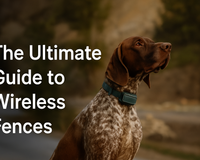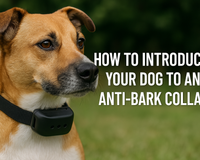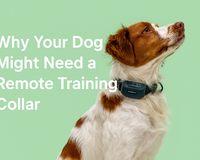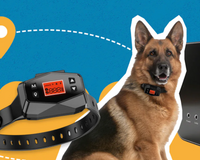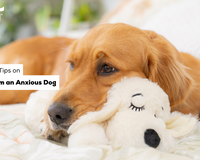Introduction to Aggressive Dogs
Dog aggression is one of the most common behavioural problems for dog owners. It can be dangerous and is the leading cause of euthanasia in dogs.
Almost all reactive, aggressive behaviour is because your dog is anxious or fearful. It usually occurs in situations where the dog feels uncomfortable.
Aggressive behaviour must be addressed as soon as possible. If your dog shifts from being a calm, confident dog into an aggressive dog, contact your vet. Your vet will conduct a full body examination to ensure that your dog’s aggression isn’t due to pain, discomfort or any other physical reason.
Once you confirm that the aggression isn’t due to a physical reason, you can begin to explore the different types and signs of dog aggression. Figuring out the why, and knowing what aggression looks like on your dog, allows you to train the aggression out of them quicker.
Types of Dog Aggression
Except for predatory dog aggression, all types of dog aggression involve a negative emotional state for the dog.Underlying Medical Cause
Specific diseases in dogs can cause reactive behaviour. Examples like thyroid dysfunction, metabolic disease, and liver disease can all cause reactivity. Arthritis, dental disease and itchy skin can all cause your dog to be in pain and uncomfortable.
The first step is always to have your dog be examined by a vet, to ensure there isn’t an underlying disease or cause going untreated.
Territorial Dog Aggression
Territorial aggression is when your aggressive dog reacts to unfamiliar dogs or people who enter their property.
This form of dog aggression is standard within reason; it is rooted in the fear/anxiety of the unknown and is your dog's attempt to scare the “threat” away.
Territorial aggression usually involves a more confident body posture, and your dog may not appear fearful. A typical example is your dog barking when they see someone coming towards your home.

Predatory Dog Aggression
Predatory dog aggression is when your dog is trying to decrease the distance between itself and a bird, small animal, infants etc. This is a form of aggression that is distance decreasing, whereas most dog aggression is distance increasing.
The sequence for predatory aggression is:
1. Eye
2. Orient
3. Stalk
4. Chase
5. Grab/Bite
6. Kill
If your dog begins to attack the prey and starts violently shaking, it means they intend to kill the target. The difference between attacking and standard predatory aggression is that your dog aims to kill.
Standard predatory dog aggression is associated with a positive state of mind and is rewarding for your dog. Most dogs display some predatory instincts and usually are motivated by the thrill of the chase more than actually catching the prey.
Redirected Dog Aggression
Redirected dog aggression is when your dog reacts to a stimulus, but it cannot get to it. Your dog then directs this frustration onto a nearby target, like another dog or a human.
An aggressive dog with redirected aggression isn’t thinking rationally; they are in fight or flight mode and need an outlet for their emotions.
A common example of this is when you’re walking your two dogs, and one becomes very excited at seeing another dog in the distance. The excited dog is unable to get to this new dog and gets agitated. The excited dog begins squabbling with the other dog you are walking, and they begin to fight.
Possessive Dog Aggression
This form of dog aggression is also known as resource guarding and occurs when your dog is trying to protect something it values from being taken from them. This valuable item could be food, a bone, a toy, a person, or a specific resting location.
Possessiveness is due to fear, anxiety and insecurity.
It’s not Breed Related
The belief that specific breeds of dogs will be aggressive is unsubstantiated by scientific studies. Any dog, no matter the size, breed, or mixture of breeds, can be dangerous. Dogs should not be considered hazardous based on their breed.Signs of Dog Aggression
Long before your aggressive dog shows its teeth, it communicates in other ways to show that it is stressed and unhappy. Learning to read their signals allows you to diffuse the situation faster.

By listening to and responding to how your dog communicates, you will gain their trust, which is vital for your relationship. The aim is to make sure your dog doesn’t feel like they have to climb up the ladder of aggression (the diagram above) to make their emotional state known.
When you are aware of the early warning signs, you will offer help to your dog quicker. Over time they will learn that they don’t need to bite or snap to feel heard. If you ignore their aggressive dog signals, they will know that biting and snapping is the only way to make their feelings be heard, and will skip straight to this step.
Each dog is different, and they all have their version of the aggression ladder. It’s your job to help your dog feel safe and climb down the ladder. Your dog is responding in the only way they know-how, and they are doing their best.
Can an Aggressive Dog be Cured?
Like most behavioural disorders, you cannot completely cure your aggressive dog, but you can reduce the frequency and intensity of their aggression. By teaching your dog healthier ways to respond to situations, or reduce the stress experienced in these situations, you’ll have a happy, calm dog instead of an aggressive dog.How Do You Stop a Dog From Being Aggressive?
There are three facets of dog aggression treatment.1. Management
Managing your aggressive dog involves you reducing the amount of triggering stimulus exposed to your dog. Once its behaviour and emotional reactions are addressed, it can go back to the environments that are potentially triggering.2. Medication
For the aggressive dogs who have anxiety or an arousal disorder, medication may be necessary. Anxiety comes from having abnormal levels of neurotransmitters in the brain, and for some cases, medication is required for treatment. Talk to your vet about your options.3. Modifications
Modifying your dog’s behaviour will be the most significant component of their emotional transformation. Modification is all about making your dog feel better about the stimulus or environment, so it isn’t motivated to react.
There are a few techniques you can use to train your dog, but all of them revolve around capturing your dog’s attention and rewarding positive reactions.
Behavioural Techniques
There are several scientific behavioural techniques you can use to modify your dog’s behaviour and train the aggression out of them.Desensitisation
Desensitisation is the technique of exposing your dog to an environment or trigger that would typically cause an undesirable reaction. This exposure is at an extremely low level so that there is no reaction from your dog.
As your dog becomes less reactive, it gets desensitised through exposure. The intensity levels of the stimulus are gradually increased.
Counterconditioning
Counterconditioning occurs when your dog reacts to a stimulus, and this reaction changes from anxious to enjoyment.
By using highly favoured rewards, every time your dog sees a trigger, their response will become positive.
An example of this is when your dog barks and lunges at your window when the postman walks by. Counterconditioning your dog would be pairing the sight and sound of the approaching postman with your dog’s favoured reward to change their emotional state.
Response Substitution
Response substitution is when an undesirable reaction, in response to a trigger, changes to a positive response. This is done by only reinforcing desirable responses. It can be a bit challenging, as you are exposing your dog to a stimulus, but only rewarding its appropriate reaction.
Desensitization, counterconditioning and response substitution are combined to teach your dog to display a new, positive and acceptable response.
Classical Conditioning
Classical conditioning refers to you as the owner, conditioning your dog’s reflexes to respond to a subtle signal. Over time your dog will learn to associate the signal with the event.
An example of this is when you're walking your dog, and it sees a trigger, you ring a bell, get them to be calm and then give them a treat. Over time your dog will associate the bell with being relaxed and receiving a treat.

Why You Shouldn’t Punish Your Aggressive Dog
Punishing aggressive dogs is counterintuitive. By punishing a dog that is frightened and uncomfortable, you will make them more uncomfortable.
It does nothing to treat the root cause of why they reacted aggressively. Continuously punishing aggressive dogs can ruin the relationship between you and your dog.
Dogs do not know right or wrong; they only know good or bad in terms of the consequences of their actions.
Training Tool Options
If you are trying to capture your dog’s attention in those incredibly stressful situations, without trying to punish them, a training collar is a great tool.
A training collar is a remote-controlled collar; you control when your dog is sent the distraction. This distraction is either a sound, citronella puff, vibration or static shock, none of which hurt your dog in any way. These collars capture your dog’s attention, much like a human hearing a whistle.
By using a training collar, you can capture your dog’s attention and reward it for staying calm.
If you’re interested in investing in an effective dog training tool, browse our selection of training collars. Transform your aggressive dog into a confident and happy dog now.







